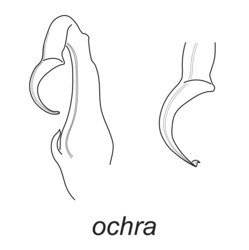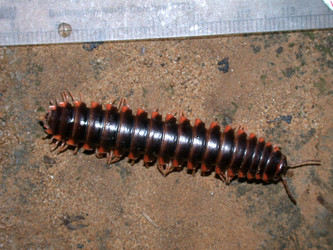Brachoria ochra
The Mississippi Mimic Millipede
Paul MarekCharacteristics
Brachoria ochra individuals are about 40.5 mm long and 10.4 mm wide (females 38.6 mm X 10.3 mm). Color: Combined striped and 2-spotted, purple medial metatergal stripes, pink lateral paranotal spots (shown above); and 2-spotted red (both morphs co-occur at Bankhead National Forest).


Brachoria ochra genitalia - left male gonopodal acropodite (with setae removed): (Left) medial view and (Right) magnified apical view. © Paul Marek


Brachoria ochra, 2-spotted red color morph. © Paul Marek
Habitat
Brachoria ochra specimens were collected during the day (17:30, Tombigbee locality) in a mixed evergreen and deciduous forest about 50 m south of Choctaw Lake. Millipedes were found beneath a layer of decaying oak leaves and pine duff. Brachoria initialis individuals were also collected from the banks of Bordon Creek in Bankhead National Forest. Here, individuals were not found under leaves but on top of them, actively walking about. Other xystodesmids encountered sympatrically at these localities are Dicellarius bimaculatus fictus (Tombigbee N.F.) and Cherokia georgiana latassa (Bankhead N.F.), the second of which appears similar in coloration with B. ochra. The species D. bimaculatus fictus, a uniform pale white color, does not appear similar to B. ochra. At Bankhead N.F., C. georgiana latassa has two color morphs: striped yellow and striped red. The striped red color morph appears similar to B. ochra (to the combined striped-spotted purple-gray and red morph).Distribution
The second largest distribution of any Brachoria species. Known from northern Alabama, south to Tuscaloosa, west into northeastern and central Mississippi to Holmes County. Not extensively distributed throughout the coastal plain, as in B. initialis.Conservation status
Brachoria ochra is threatened by habitat loss due to agriculture (especially growing demand for paper products), coal mining, development, and the invasion of exotic species.References
Marek P.E. 2010. A revision of the Appalachian millipede genus Brachoria Chamberlin, 1939 (Polydesmida: Xystodesmidae: Apheloriini). Zool. J. Linn. Soc. 159: 817-889.
Chamberlin R.V., Hoffman R.L. 1958. Checklist of the millipeds of North America. Bull. U.S. Nat. Mus. 212: 1-236.
Chamberlin R.V. 1918. Myriapods from Nashville, Tennessee. Psyche 25: 23-30.
Chamberlin R.V. 1939. On some diplopods of the family Fontariidae. Bull. Univ. Utah 30: 1-19.
Keeton W.T. 1959. A revision of the millipede genus Brachoria (Polydesmida: Xystodesmidae) Proc. US Nat. Mus. 109: 1-58.
Keeton W.T. 1965. Descriptions of three new species of Brachoria, with notes on established species (Diplopoda, Polydesmida, Xystodesmidae). Proc. Biol. Soc. Wash. 78: 225-240.
Hoffman R.L. 1948. Two new genera of xystodesmid millipeds from eastern United States. Proc. Biol. Soc. Wash. 61: 93-96.
Hoffman R.L. 1999. Checklist of the millipeds of North and Middle America. Virginia Museum of Natural History Special Publication. No. 8. Martinsville: Virginia Museum of Natural History.
Title Illustrations

| Scientific Name | Brachoria ochra |
|---|---|
| Location | USA, Alabama, Lawrence Co. |
| Reference | Marek P.E. 2010. A revision of the Appalachian millipede genus Brachoria Chamberlin, 1939 (Polydesmida: Xystodesmidae: Apheloriini). Zool. J. Linn. Soc. 159: 817-889. |
| Specimen Condition | Live Specimen |
| Sex | m |
| Life Cycle Stage | adult |
| View | dorsal |
| Collection | FMNH |
| Collector | Paul Marek |
| Image Use |
 This media file is licensed under the Creative Commons Attribution-NonCommercial License - Version 3.0. This media file is licensed under the Creative Commons Attribution-NonCommercial License - Version 3.0.
|
| Copyright |
© Paul Marek

|
About This Page
Work on the millipede Tree of Life pages was supported by a U.S. National Science Foundation Doctoral Dissertation Improvement Grant to Paul Marek and Jason Bond (DEB 0607996) and a Partnerships for Enhancing Expertise in Taxonomy Grant to Petra Sierwald, Jason Bond, and William Shear (DEB 0529715).
Paul Marek

Virginia Polytechnic Institute and State University
Correspondence regarding this page should be directed to Paul Marek at
brachoria@gmail.com
Page copyright © 2010 Paul Marek
 Page: Tree of Life
Brachoria ochra . The Mississippi Mimic Millipede.
Authored by
Paul Marek.
The TEXT of this page is licensed under the
Creative Commons Attribution-NonCommercial License - Version 3.0. Note that images and other media
featured on this page are each governed by their own license, and they may or may not be available
for reuse. Click on an image or a media link to access the media data window, which provides the
relevant licensing information. For the general terms and conditions of ToL material reuse and
redistribution, please see the Tree of Life Copyright
Policies.
Page: Tree of Life
Brachoria ochra . The Mississippi Mimic Millipede.
Authored by
Paul Marek.
The TEXT of this page is licensed under the
Creative Commons Attribution-NonCommercial License - Version 3.0. Note that images and other media
featured on this page are each governed by their own license, and they may or may not be available
for reuse. Click on an image or a media link to access the media data window, which provides the
relevant licensing information. For the general terms and conditions of ToL material reuse and
redistribution, please see the Tree of Life Copyright
Policies.
- First online 16 September 2010
- Content changed 16 September 2010
Citing this page:
Marek, Paul. 2010. Brachoria ochra . The Mississippi Mimic Millipede. Version 16 September 2010 (under construction). http://tolweb.org/Brachoria_ochra/144230/2010.09.16 in The Tree of Life Web Project, http://tolweb.org/






 Go to quick links
Go to quick search
Go to navigation for this section of the ToL site
Go to detailed links for the ToL site
Go to quick links
Go to quick search
Go to navigation for this section of the ToL site
Go to detailed links for the ToL site